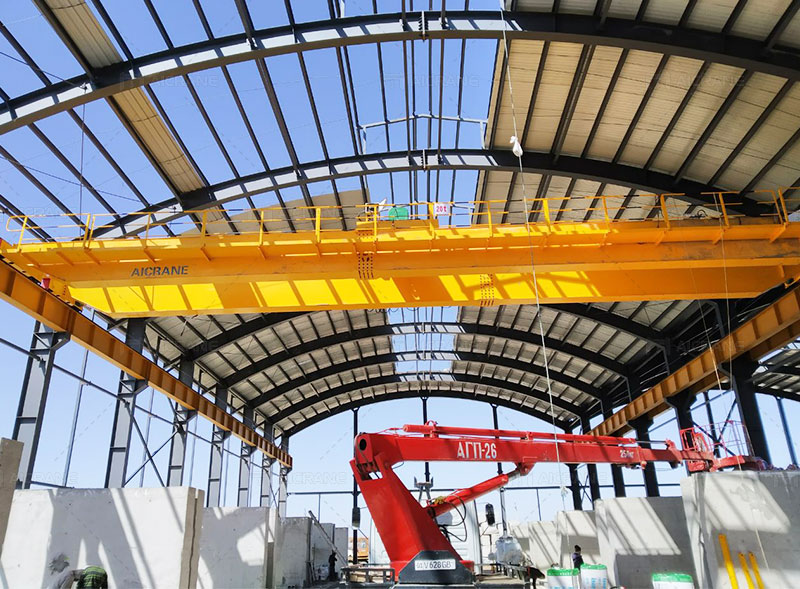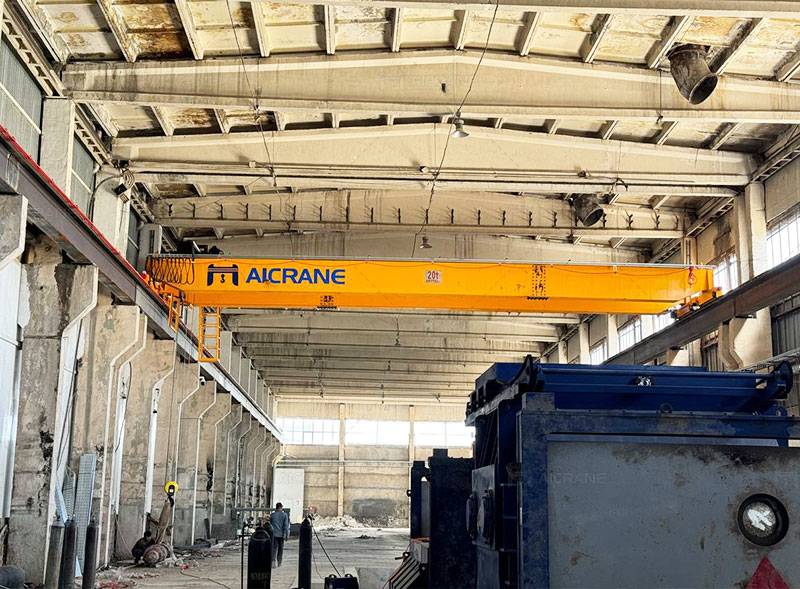Double girder bridge cranes are a cornerstone of heavy-duty lifting operations in a variety of industries, from manufacturing and construction to shipping and power plants. The lifting capacity of these cranes plays a crucial role in determining their suitability for different tasks. With a wide range of lifting capacities available, it’s essential to understand how to select the right capacity based on the specific requirements of the customer’s operations. In this article, we will explore the capacity range of double girder bridge cranes and provide insights into choosing the right lifting capacity based on customer needs.

1. Introduction to Double Girder Bridge Cranes
A double girder bridge crane is an overhead crane design that uses two parallel beams (or girders) running along the length of the crane. These beams support the trolley and hoist mechanism, which is responsible for lifting and lowering loads. Double girder bridge cranes are highly versatile and can carry much heavier loads compared to single girder cranes due to their more robust design. This makes them ideal for applications that require high lifting capacities, such as in manufacturing plants, warehouses, shipyards, and power stations.
The lifting capacity of a double girder bridge crane refers to the maximum weight it can safely lift and transport. This capacity is measured in tons and can vary from as little as a few tons to several hundred tons, depending on the crane’s design and application.
2. The Capacity Range of Double Girder Bridge Cranes
Double girder bridge cranes come in a wide range of lifting capacities, from small cranes used for light-duty operations to heavy-duty cranes designed for the most demanding tasks. The general range of lifting capacities is as follows:
2.1 Light-Duty Cranes (Up to 20 tons)
These cranes are typically used in environments where moderate lifting is required. They are common in smaller workshops, warehouses, and production lines where the load requirements are relatively low.
-
Applications: Light-duty double girder 1 ton to 20 ton overhead cranes are typically used for handling smaller loads like machinery, small parts, or moderate weight materials.
-
Capacity range: 1 ton to 20 tons
-
Span range: 3m to 20m

2.2 Medium-Duty Cranes (20 tons to 50 tons)
Medium-duty cranes are widely used across various industrial sectors, including the automotive, construction, and logistics industries. These cranes are designed to lift moderately heavy loads and can be configured for high-speed operations. They can handle heavier loads than light-duty cranes and are built to withstand regular use in industrial settings.
-
Applications: Medium-duty double girder 20 ton to 50 ton bridge cranes are ideal for lifting items such as structural components, heavy parts, and large equipment in factories and warehouses.
-
Capacity range: 20 tons to 50 tons
-
Span range: 10m to 30m
2.3 Heavy-Duty Cranes (50 tons to 150 tons)
Heavy-duty cranes are used in industries where lifting capacities of 50 tons or more are required. These cranes are commonly seen in large manufacturing facilities, shipyards, and power plants where very heavy loads, such as large machinery, steel components, and precast concrete elements, need to be moved. Heavy-duty cranes are designed for continuous, high-intensity use and require more robust construction.
-
Applications: These cranes are typically found in industries such as power generation, heavy manufacturing, shipbuilding, and steel production.
-
Capacity range: 50 tons to 150 tons
-
Span range: 15m to 35m
2.4 Super Heavy-Duty Cranes (150 tons and Above)
These are the most powerful double girder bridge cranes, capable of lifting extremely heavy loads. They are often used in specialized applications, such as the installation of large equipment, components, and in shipyards where enormous loads need to be moved. These cranes are often custom-built to meet specific requirements, such as lifting very heavy machinery, structural components, and large construction materials.
-
Applications: Heavy industries, large-scale construction projects, shipbuilding, and the lifting of massive components like turbines, generators, and large steel structures.
-
Capacity range: 150 tons and above
-
Span range: 20m to 50m (or more)
3. Factors to Consider When Choosing the Right Lifting Capacity
Selecting the right lifting capacity for a double girder bridge crane is a critical decision that requires careful consideration of several factors. Choosing the wrong crane capacity can lead to inefficiencies, increased operational costs, or even safety risks. Below are the key factors that customers should evaluate when determining the appropriate lifting capacity.
3.1 Load Type and Weight
One of the most obvious factors in determining the appropriate lifting capacity is the type and weight of the loads that the crane will be handling. Customers should accurately estimate the weight of the heaviest load that the crane will need to lift on a regular basis. However, it’s important to account for not only the maximum weight but also any potential fluctuations in load weight over time.
-
Tip: Always overestimate the load weight slightly to account for any unforeseen increases in weight or unexpected load shapes that may make handling more challenging.
3.2 Frequency of Use
The frequency with which an overhead bridge crane for sale will be used is another crucial factor. Cranes in operations with continuous or frequent use (e.g., manufacturing plants) may require a crane with a higher duty cycle to ensure durability and reliability. The higher the lifting capacity, the greater the load on the crane’s components. Customers in high-intensity industries should choose a crane that is built for such demands.
-
Duty classification: Crane duty classes such as A3, A4, A5, and A6 indicate the frequency of use and the stresses the crane will face. More frequent use calls for a more robust crane design with a higher capacity.
3.3 Work Environment
The work environment also plays a significant role in selecting the right crane capacity. Factors such as the available space, height limitations, environmental conditions (temperature extremes, humidity, dust, or corrosive elements), and the complexity of lifting operations can all influence the choice of crane capacity.
-
Indoor vs. outdoor use: For outdoor use, cranes often need to be rated for handling environmental challenges such as wind, rain, and extreme temperatures, which may require additional capacity for safety margins.
3.4 Load Handling Requirements
In some cases, the crane might need to handle more than just weight. The configuration of the load, such as awkward shapes, unusual dimensions, or the need for high-precision lifting, can dictate the need for a higher lifting capacity.
-
Example: If the crane is required to handle long or oversized materials (like beams, pipes, or large panels), it may require special hoists or features like a wider span, which may increase the load-bearing capacity requirements.
3.5 Safety and Compliance Standards
Safety should always be a top priority in crane selection. Each crane capacity range has its own associated safety regulations and design requirements. Double girder cranes are often equipped with advanced safety features, including overload protection systems, anti-sway mechanisms, and emergency stop functions. Choosing a crane with the appropriate safety features ensures that operations run smoothly without putting workers at risk.
-
Compliance: Check industry regulations (OSHA, ISO, ASME, etc.) to ensure that the crane meets all safety standards for the intended application.
4. Benefits of Choosing the Right Lifting Capacity
Choosing the right lifting capacity brings several benefits to customers:
-
Efficiency: A crane with the correct capacity ensures smooth and efficient lifting operations, as it is neither underpowered nor overpowered for the tasks at hand.
-
Cost-Effectiveness: A properly sized crane will operate more economically, reducing energy consumption and minimizing wear and tear on the crane components.
-
Safety: Properly matched crane capacity lowers the risk of accidents due to overloading, ensuring that the crane operates safely within its limits.
-
Longevity: A crane that is selected to handle the right amount of load is less likely to suffer from premature wear or failure, ensuring a longer operational lifespan.
5. Conclusion
Double girder bridge cranes are versatile and powerful tools that play a central role in many industries. Choosing the appropriate lifting capacity is crucial to ensuring efficient and safe operations. By carefully considering factors such as the load type, frequency of use, work environment, and safety requirements, customers can make an informed decision that enhances their operational efficiency and reduces long-term costs.
Whether handling light, medium, or heavy loads, the right crane capacity ensures that businesses can carry out their lifting operations with confidence and reliability. Therefore, understanding the capacity range of double girder bridge cranes and how to match the right crane to the customer’s specific needs is key to achieving optimal performance and value.
